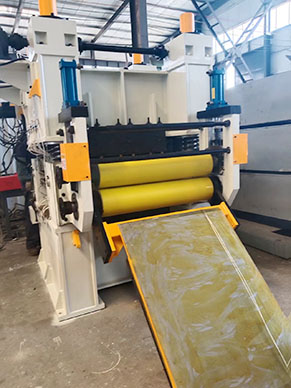Flattening Machine
Production Speed: The production speeds of different models of flattening machines vary. Generally, they are between 5m/min and 20m/min and can be adjusted according to production requirements to achieve the best production efficiency.
High Precision Flatness: Through precise mechanical structure design and advanced control systems, it can adjust the unevenness on the surface of materials to a very small error range, meeting the processing requirements of various products with high flatness requirements.
Metal Processing Industry: In the pre-treatment stage of metal sheets, such as in industries such as automobile manufacturing, mechanical manufacturing, electronic equipment manufacturing, etc., it is used to adjust the flatness of the purchased metal sheets for subsequent processing operations such as cutting, stamping, bending, etc., improving product quality and processing accuracy.
Automatic Feeding Device: According to needs, an automatic feeding mechanism can be equipped to realize the automatic conveyance and feeding of materials, further improving production efficiency and reducing manual intervention.
Special Material Processing Accessories: For the processing of some special materials or with special process requirements, corresponding processing accessories can be provided, such as high-temperature resistant rollers, anti-static devices, etc., to meet the personalized needs of different users.

Production Process
Optimizing the Production Process: Conduct a detailed review and optimization of the technological process for producing flattening machines. Eliminate unnecessary links and steps to improve production efficiency. For example, adopt a parallel production method where different components are manufactured simultaneously and then assembled, thereby shortening the overall production time.
Preparing Materials in Advance: Based on the production plan and order forecasts, purchase and stockpile commonly used raw materials and components in advance to avoid production stoppages due to raw material shortages. Meanwhile, establish a strict raw material inventory management system to ensure that the quality and quantity of materials meet production requirements.
Increasing Production Shifts: In urgent order situations, appropriate increases in production shifts can be made by implementing a multi-shift system to fully utilize equipment and human resources and accelerate the production progress. However, it is necessary to arrange employees' working hours and rest periods reasonably to avoid excessive fatigue affecting production quality.
Introducing Advanced Production Technologies: Invest in and introduce advanced production technologies and equipment, such as automated production lines and CNC machining centers, to enhance the degree of automation and processing precision of production, thereby significantly improving production efficiency and shortening the production period while ensuring product quality.

Based on the geographical location of customers and their delivery time requirements, the quickest logistics mode should be chosen. For customers in close proximity, same-city express delivery or dedicated vehicle delivery can be selected. For customers at a long distance, priority should be given to rapid transportation means such as air transportation or high-speed rail express to shorten the transportation time.
Form a close cooperative relationship with professional logistics enterprises by signing long-term cooperation agreements to strive for more favorable logistics prices and more preferential services. Logistics enterprises can arrange vehicles and transportation plans in advance to ensure the timely dispatch of goods and provide real-time logistics tracking information, facilitating both the shipper and the consignee to keep abreast of the transportation status of the goods.
Design a reasonable packaging solution that not only ensures the safety of the equipment during transportation but also minimizes the volume and weight of the packaging to improve transportation efficiency. Adopt lightweight, sturdy, and recyclable packaging materials to reduce packaging costs while also facilitating loading, unloading, and transportation.

Submitted successfully
We will contact you as soon as possible



